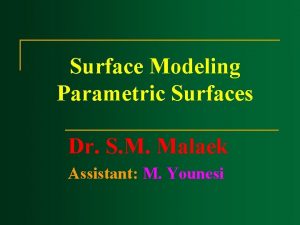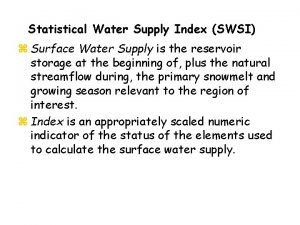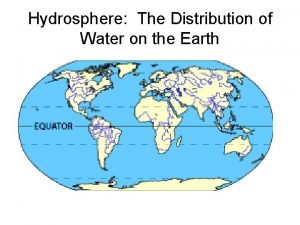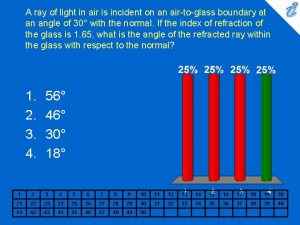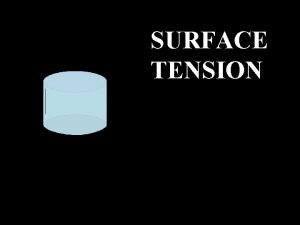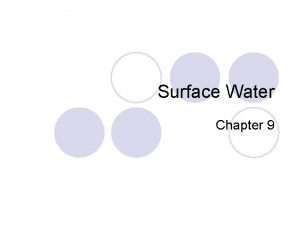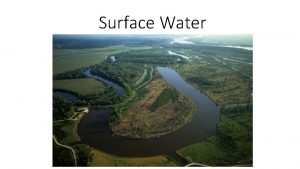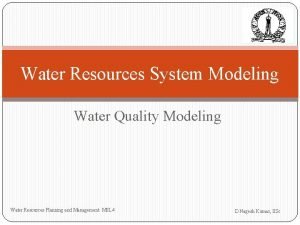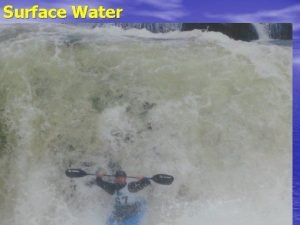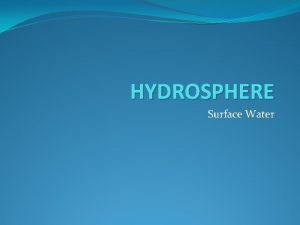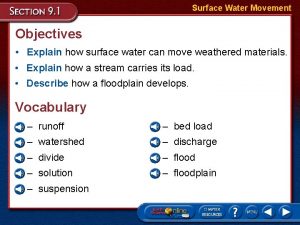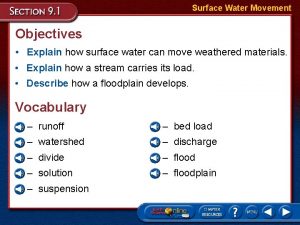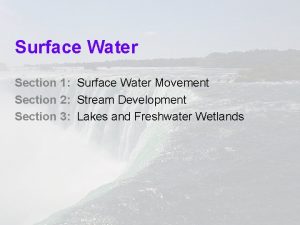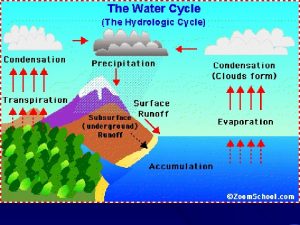CE 5362 Surface Water Modeling 1 D2 D


















- Slides: 18

CE 5362 Surface Water Modeling 1 D/2 D Hydrodynamic Models

2 D Diffusion Hydrodynamic Model 2 D horizontal flow – an extension of St. Venanttype formulation Assume: Hydrostatic pressure distribution; constant density; planar dimension (x, y) much larger then vertical dimension (z) cite{DHM-report}

2 D Diffusion Hydrodynamic Model Sketch of a computational cell x, y directions shown, z is up. Within the cell, average flow depth is h On the 4 cell faces, are the flux terms Q, shown here as series expansions about the cell center. Apply continunity principle

2 D Diffusion Hydrodynamic Model Sketch of a computational cell x, y directions shown, z is up. Within the cell, average flow depth is h On the 4 cell faces, are the flux terms Q, shown here as series expansions about the cell center. Apply continunity principle

2 D Diffusion Hydrodynamic Model Apply continunity principle Where,

2 D Diffusion Hydrodynamic Model Momentum-x Momentum-y

2 D Diffusion Hydrodynamic Model DHM moniker comes from next few steps, where the momentum terms are converted into linear-flux law terms so the equations of motion can be placed directly into continunity and a diffusion equation results. The PDE is pretty non-linear, but the construction allows use of very stable methods

2 D Diffusion Hydrodynamic Model First divide momentum by gh

2 D Diffusion Hydrodynamic Model First divide momentum by gh

2 D Diffusion Hydrodynamic Model Rename the leftmost three terms “m” (a function of current state)

2 D Diffusion Hydrodynamic Model Stipulate that the friction slope is well approximated by Chezy/Manning formulation

2 D Diffusion Hydrodynamic Model Rewrite in terms of momentum equations

2 D Diffusion Hydrodynamic Model Substitute into continunity, and the result is a diffusion equation in H, quite non-linear.

2 D Diffusion Hydrodynamic Model Solving takes a trial-and-error approach (hence a lot of iteration) General algorithm is: 1) Between nodes points (velocity grid) compute average Manning’s n, average geometric factors (h) 2) Assume m=0, estimate nodal flow depths for next time (t+Dt) using the momentum equations (as difference equations) 3) Use these new depths, and old depths to estimate the midtimestep value of m (including the dynamic components, this could be an elaborate computation) 4) Recompute values of K using these midstep m values 5) Find flow depths at next time (t+Dt) using continunity (same as step 2, but with midstep m values) 6) Return to step 3 and repeat until K matches the midstep estimate – declare that convergence and update, proceede to next time step.

2 D Diffusion Hydrodynamic Model Solving takes a trial-and-error approach (hence a lot of iteration) General algorithm is: 1) Between nodes points (velocity grid) compute average Manning’s n, average geometric factors (h) 2) Assume m=0, estimate nodal flow depths for next time (t+Dt) using the momentum equations (as difference equations) 3) Use these new depths, and old depths to estimate the midtimestep value of m (including the dynamic components, this could be an elaborate computation) 4) Recompute values of K using these midstep m values 5) Find flow depths at next time (t+Dt) using continunity (same as step 2, but with midstep m values) 6) Return to step 3 and repeat until K matches the midstep estimate – declare that convergence and update, proceede to next time step.

2 D Diffusion Hydrodynamic Model Grid system is complicated, there are 3 grids A grid of depth nodes, A grid of Qx nodes, A grid of Qy nodes

2 D Diffusion Hydrodynamic Model Grid system is complicated, there are 3 grids A grid of depth nodes, A grid of Qx nodes, A grid of Qy nodes

2 D Diffusion Hydrodynamic Model Grid system is complicated, there are 3 grids A grid of depth nodes, A grid of Qx nodes, A grid of Qy nodes An effective naming scheme is important
 Water and water and water water
Water and water and water water Helen erickson biography
Helen erickson biography Dimensional modeling vs relational modeling
Dimensional modeling vs relational modeling Parametric surface modeling
Parametric surface modeling What is a lateral area
What is a lateral area Spin coat
Spin coat Volume and surface area of cone
Volume and surface area of cone Surface water supply index
Surface water supply index Njdep surface water quality standards
Njdep surface water quality standards Tceq segment viewer
Tceq segment viewer How is water distributed in the hydrosphere
How is water distributed in the hydrosphere Water flowing downslope along earth's surface
Water flowing downslope along earth's surface Texas surface water quality standards
Texas surface water quality standards Chapter 9 surface water chapter assessment answer key
Chapter 9 surface water chapter assessment answer key Hydrosphere groundwater
Hydrosphere groundwater How does water purity affect surface tension hypothesis
How does water purity affect surface tension hypothesis A ray of light in glass is incident on a boundary with air
A ray of light in glass is incident on a boundary with air How much of the earth's surface is covered with water
How much of the earth's surface is covered with water Surface tension meaning
Surface tension meaning



